A Stroke of Good Luck: Dickinson Lent a Hand and Got Hers in Return
In golf, Ben Hogan is a mythical character about on the order of a Lincoln in history, or an Ivanhoe in literature, Mozart in music. You don’t know what to believe.
There once was a guy who walked like Hogan, talked like Hogan, smoked like Hogan, ate like Hogan, thought like Hogan and hoped he played like Hogan. When he found out Hogan practiced till dark every day, he followed suit. One night, he came into a bar, his hands raw and bleeding and blistered and cut from a day on the tee and he began to sob. “God! I wish that Hogan wore a glove!”
In real life, Gardner Dickinson Jr. was almost the real-life version of that character. Gardner yielded to no man in his adoration of Hogan. Gardner didn’t wear a glove either. He wore a white hat like Hogan, he wore conservative gray-and-black clothing like Hogan, he chain-smoked like Hogan, swung like Hogan until, one day in 1953, in the Pan American Open in Mexico City, Hogan himself took notice of this clone and, to everyone’s considerable surprise, was sympathetic. Hogan uncharacteristically offered to tutor this alter ego and recommended he come to Palm Springs for a remake of his game.
It was like being asked to study art under Rembrandt for Gardner, who took the next bus for Hogan’s course, and for the next 20 years, the legend of Ben Hogan was alive and well on the fairways of America, where Gardner was The Hawk II, and a generation of golf fans were heard to ask, “Is that Hogan over there?” only to be told, “No, that’s just Gardner Dickinson, he just looks like Hogan.” Golfer Jimmy Demaret used to like to say: “Gardner will never be happy till he gets hit by a bus!”
The resemblance didn’t exactly stop at the first tee. Gardner won eight tournaments. You get a ticker-tape parade today for eight tournament wins, but no one ever mistook Gardner Dickinson for Ben Hogan after he hit the ball. Gardner was good but not immortal. You could tell right away when he swung that it wasn’t the real Hogan, but it was a reasonable facsimile.
Gardner had one habit he didn’t get from Hogan. He liked to help people. Old-timers used to say about the only advice they ever got from Hogan on the course was the tip that they were away. But Gardner had this disturbing tendency that he couldn’t stand to see faults in other people’s swings. He was a born pedagogue.
It was annoying to Hogan. “Ben used to tell me, ‘What are you doing, helping all those people taking bread off your table? Why don’t you just take your wallet-full of money and throw it out there on the practice range for them to help themselves?’ ” Dickinson recalls.
Gardner couldn’t help it. “Guys like Miller Barber would come up to me and say ‘Come look at me for five minutes, Gardner. You got to come watch me. I can’t do a thing.’ And I would go out on the practice tee and stay five hours with him.”
It was the only thing Dickinson did that was non-Hogan, but his reputation as a swing doctor grew until one day a few years ago a golfer with a problem showed up on his doorstep in West Palm Beach, Fla.
This golfer didn’t at all put him in mind of Hogan although they were both on the short side and both had blue eyes. This golfer didn’t wear a white hat or conservative garb but, like the young Hogan, had big trouble with a duck hook.
The teacher in Gardner Dickinson came out. This was followed in due course by the romanticism in Gardner Dickinson. He began to notice a lot more about this golfer than the swing. He began to notice the golfer attached was a 5-foot, 4-inch, 120-pounder with a cute nose and that, if the swing wasn’t compact, the rest of Judy Clark sure was.
Gardner not only changed her game, he changed her name. It was not that her game was so terminal it required a whole new alias, it was more that having Judy as pupil was a lot more distracting than having Miller Barber even though Judy had a slight loop at the top of the backswing, too. He married her.
No one ever thought of the Wedding March as a cure for a sweep slice before. When a game needs a priest it’s really in intensive care.
But the golf game was the only part of Judy Clark in need of any repair.
In high heels, Judy was on life’s fairway. In cleats, she kept finding herself in the deep rough. She had this built-in lunge that she remembers almost coming out of her shoes at impact. The balls tended to behave like leaflets dropped from a high-flying plane. They came to Earth randomly, often in sand, sometimes in water, always in trouble.
“In those days you could stay on the tour shooting 75s and 76s,” Judy recalls. “The cuts would usually be in the high 150s.” For Judy this was a good thing.
When she first took her game to Gardner he was not interested in her play--or the player. “Once he told me to go down in a bunker and not come out till I could get up and down in 2,” she remembers.
It all came out like a Doris Day movie. Gardner might have noticed the blue eyes and brown legs first, but he soon noticed they came with a pretty good basic swing attached.
“She has all the tools. She should be winning out there every other week,” Gardner insists. “She has to learn to believe in herself.”
Not even a good marriage can lock in that part of the game, but the name “Dickinson” began to go up on a golf leader board again last year and even won its first tournament in a decade when Judy topped the LPGA at the Boston Five tournament last summer.
Judy’s biggest problem was not mechanical, it was mental. This professor had more to teach her than that the rains in Spain stay mainly in the plains. In their version, our fair lady had to learn to overcome self-consciousness. “I had stage fright,” Judy recalls. “I’d find myself in the lead in a tournament and I’d think ‘Oh, oh, all these people are looking at me.’ ”
Hogan used to like crowds. They framed the green for one thing. But Judy found herself throwing away a seven-shot lead at St. Petersburg once and staggering down the stretch in other opens struggling not to blush. Golf is a game you can’t play embarrassed.
To be a good golf teacher it helps to have a degree in clinical psychology. Fortunately, Judy’s Svengali did. And Mentor Dickinson soon had the new Mrs. Dickinson convinced that winning was more a state of mind than body.
Judy’s game improved last year to the extent she was ninth on the women’s money list with $167,809 and was a winner with a stroke average of 72.27 and one of the threats in the Nabisco Dinah Shore tournament down here at Mission Hills this week.
She may not win. But the Dickinsons have a hole card. The real Hogan is still down there in Fort Worth and may have time for one more Hogan clone to bedevil the nation’s fairways before the world forgets.
More to Read
Go beyond the scoreboard
Get the latest on L.A.'s teams in the daily Sports Report newsletter.
You may occasionally receive promotional content from the Los Angeles Times.










